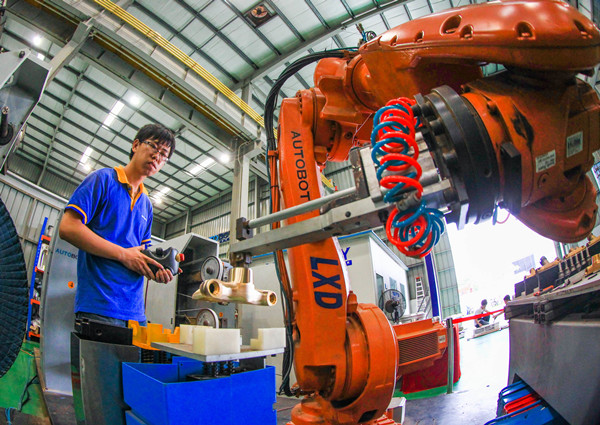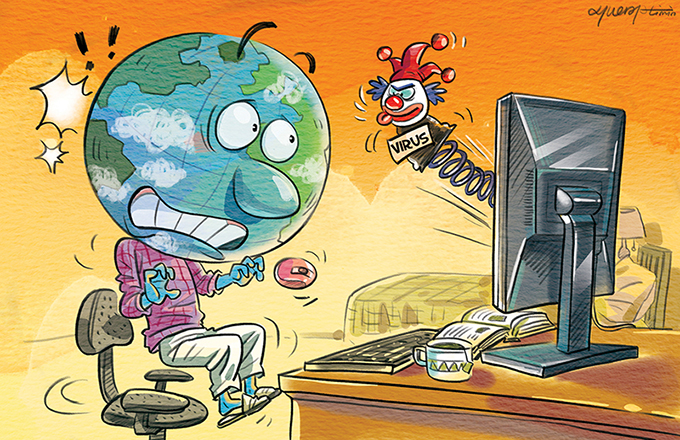On way to achieving targeted growth rate
China's economy remains on a solid footing, according to the National Bureau of Statistics, which released the macroeconomic data for April on Monday. However, some indicators show China may face downward pressure in the second half of this year.
 |
|
A worker assembles a robotic arm at a factory in Foshan, Guangdong province. [Provided to China Daily] |
Industrial output in April grew 6.5 percent year-on-year. Although it was lower than the 7.6 percent growth in March, it was higher compared with the figures for most of the months last year (the highest monthly growth last year was 6.8 percent, in March 2016), indicating the economy is still edging up.
The job market remained stable, with the surveyed unemployment rate in 31 major cities being below 5 percent in recent months. And in the first four months of this year, China created 4.65 million jobs, 220,000 more than the same period last year.
Inflation remained stable in April, as the consumer price index increased slightly, from 0.9 percent to 1.2 percent in March. Such a mild increase in the CPI indicates rising economic activities and a relatively stable inflation level.
China's balance of international payment, indicated by its foreign exchange reserves, also stabilized given that the reserves stayed around $3 trillion in recent months. In fact, China's foreign exchange reserves have increased for three consecutive months to reach $3.03 trillion.
The April data show that after registering an unexpectedly high GDP growth of 6.9 percent in the first quarter of this year, China has managed to maintain the basic momentum of growth. Therefore, it is very likely that China will meet its targeted year-on-year GDP growth of at least 6.5 percent this year.
But the drop in producer price index in April-down to 6.4 percent from 7.8 percent in February and 7.6 percent in March-should make policymakers aware that China's industrial activities could weaken in the upcoming months.
And considering the unfolding effects of the tightening measures imposed by local governments on the real estate markets, the downside pressure could be even greater in the last quarter of the year.
The area of property sold grew 7.7 percent year-on-year in April, the lowest since December 2015 and a sharp decline compared with March, when it was as high as 14.7 percent. But the weakening sales have failed to thwart investment, as China's real estate investment defied nationwide regulatory tightening to pick up to 9.3 percent in the first four months, up from 9.1 percent registered in the first quarter and 8.9 percent in January and February combined.
The trend shows that there could be a time lag between the tightening policies and the slowdown in real estate investment growth. The effects of the tightening measures and the tightening of the overall monetary policy across the country could start to bite in the second half of this year, and thus affect overall growth.
China also has steadied the real interest rates in recent months and strengthened financial regulation to strictly manage the previously less-regulated financial products, such as wealth management products, to ward off financial risks. Such moves have made banks much more cautious in extending loans, which could restrict investment in infrastructure and other fixed-asset projects and therefore dampen overall economic activities.
Such a scenario, which cannot be ruled out, can undermine the country's efforts to meet its growth target. But given the high growth rate in the first quarter of this year, the target growth rate can be achieved even if the economy weakens slightly in the second half. Plus, a relatively slow growth will not rattle policymakers, as they have made preventing financial risks their priority.
At a meeting of the Political Bureau of the Central Committee of the Communist Party of China late last month, the leadership said the country must make efforts to prevent financial risks. The meeting sent a clear message that the country will strike a balance between achieving stable economic growth and ensuring a safe financial environment, with the latter being a more urgent task.
The author is a senior writer with China Daily.
xinzhiming@chinadaily.com.cn
- China's sharing economy: $501 billion market volume
- Mining becomes tourist attraction to fuel economy
- Chinese economy shows firming signs amid restructuring efforts
- World Bank head says initiative good for world economy
- A new growth point for world economy
- Internet-based economy boosts China's GDP, creates jobs

















